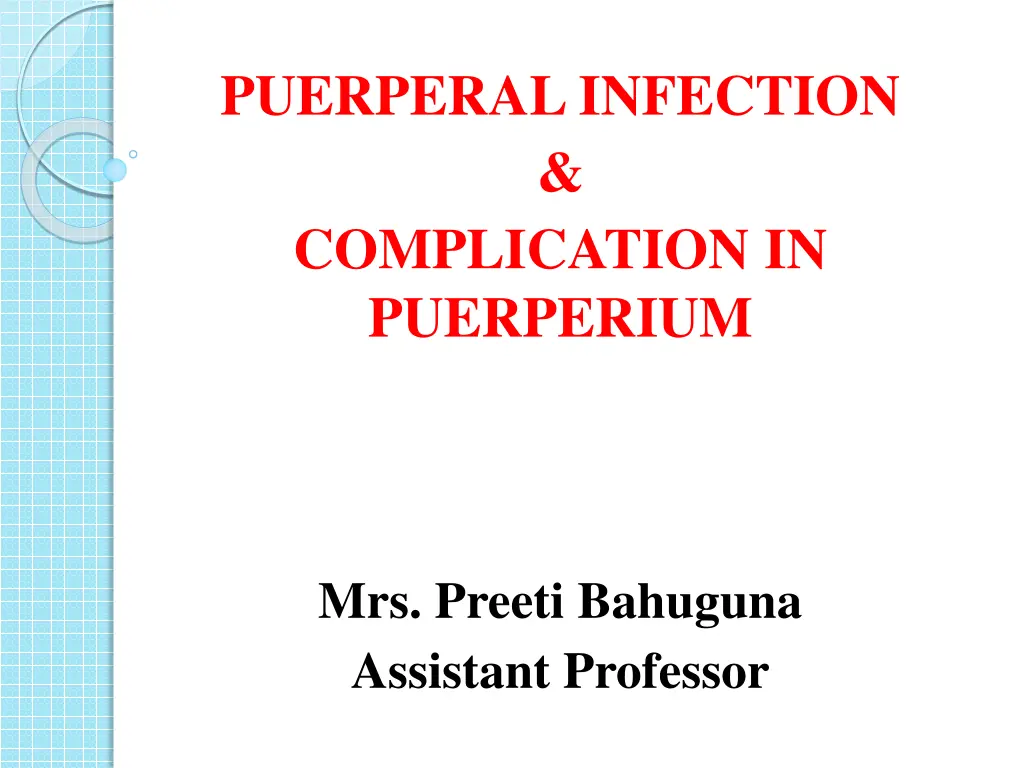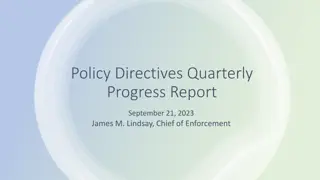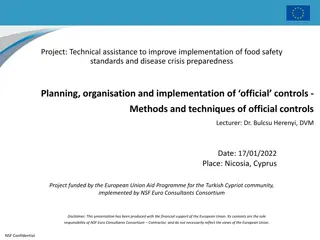
Complications in Puerperium: Causes, Symptoms, and Management
Learn about puerperal infections and complications in the postpartum period, including causes like urinary tract infections, genital infections, mastitis, and more. Explore symptoms, treatments, and risk factors associated with puerperal pyrexia. Understanding these issues is crucial for early detection and management to prevent serious morbidity and mortality in new mothers.
Uploaded on | 0 Views
Download Presentation

Please find below an Image/Link to download the presentation.
The content on the website is provided AS IS for your information and personal use only. It may not be sold, licensed, or shared on other websites without obtaining consent from the author. If you encounter any issues during the download, it is possible that the publisher has removed the file from their server.
You are allowed to download the files provided on this website for personal or commercial use, subject to the condition that they are used lawfully. All files are the property of their respective owners.
The content on the website is provided AS IS for your information and personal use only. It may not be sold, licensed, or shared on other websites without obtaining consent from the author.
E N D
Presentation Transcript
PUERPERAL INFECTION & COMPLICATION IN PUERPERIUM Mrs. Preeti Bahuguna Assistant Professor
INTRODUCTION Puerperium also referred to as the fourth trimester is the period between childbirth and the return of the uterus to its normal size . The mother may develop complications that may associated with significant morbidity and mortality if they are not diagnosed in the early stages. Common complication are hemorrhage ,infection , hematoma
Puerperal infection and pyrexia Postpartum infection occur after hospital discharge which is usually 24 hrs. after delivery. The chief of puerperal infection and pyrexia include endometritis, wound infection, mastitis, urinary tract infection
Puerperal pyrexia An elevation of temperature to 38.c (100.F) or more occurring on two separate occasions at 24 hours apart ( excluding the first 24 hours )within the first 10 days
Causes Urinary tract infection: E. coli Dysuria Hematuria Frequency Genital tract infection: Tender and bulky uterus Prolonged bleeding Discolored lochia
Painful inflamed perineum Caused by E.coli Mastitis: Flu like symptoms Painful , hard , red breast Nipple trauma and cellulitis
Postoperative infection: Lscs is the most important risk factor for puerperal pyrexia In uk there is an 8% risk of infection following Lscs Painful suture line Deep tenderness Lochia pink Deep vain thrombosis: a low grade pyrexia can be caused by venous thromboembolism Painful or swollen calf
Other infection Pyrexia is a recently delivered mother may also be due to such as viral infection of chest infection Glandular fever is probably a common cause of fever in postpartum period
HISTORY: Full history should be taken to include a full history of the delivery establish When the membrane ruptured The length of the labor Instrumentation used Sutures required Whether the placenta was complete Whether there was any bleeding during or after delivery
examination Take temp. and B.P Palpate uterus to assess size and tenderness Assess perineal wound and lochia Examine breast Examine chest for sign of infection Examine the legs
INVESTIGATIONS: High vaginal swab Urine culture FBC Blood culture Ultrasound Sputum culture
MANAGEMENT General Measures: Ice packs may be helpful for pain Rest and adequate fluid intake
The following sign and symtoms should be prompt urgent referral for hospital assessment if the women appears seriously unwell: Pyrexia II. Sustained tachycardia III. Breathlessness IV. Abdominal or chest pain V. Diarrhea and vomiting VI. Uterine or renal angle pain I.
Pharmacological Analgesia may be required if the fever is prolonged then treatment with heparin should also be considered NSAIDs should be avoided for pain relief in case of sepsis Surgical: If the abscess formed in that case the fever will not settle until the abscess has be incised and drained.
Prevention Scrupulous attention to hygiene should be used during all examination and use of instrumentation during and after labor Any gas identified during pragnancy should be treated aggressively Early mobilization
definition Puerperal infection is an infection of the genital tract which occurs as a complication of delivery
Puerperal sepsis Even in 21stcentaury at least 75,000 women die annually worldwide of puerperal sepsis mostly in the low income countries. In Uk sepsis in the puerperium remain important cause of maternal death. incidence: puerperal infection morbidity affects 2-10% of patient. 5-10 times higher in cesarean delivery.
Common puerperal infections Endometritis Endomyometritis Endoparametritis
Causative organism Doderlein bacillus(60-70%) Yeast like fungus- candida albicans (25%) Staphlyococcous albus or aureus Streptococcous- anerobic common Beta hemolyticus streptococcous rare e.coli Clostridium welchii
predisposing factors
Antepartum factor Malnutrition Pre eclampsia Preterm labor Sexual intercourse during late pregnancy Premature rupture of membrane Prolonged rupture of membrane diabetes
Intrapartum factor Repeated vaginal examination Dehydration and ketoacidosis during labor Traumatic operative delivery Hemorrhage Retained bits of placenta tissue Placenta Previa Cesarean delivery
Pathology Puerperal infection is wound infection the primary site of infection Perineum Vagina Cervix Uterus
perineum Laceration of the perineum are likely to infected The wound edges become red and swallon There may be collection of purulent discharge resulting in complete disruption of the wound Vagina: Vaginal laceration are infected directly or by extension from the perineal infection The mucosa is swallon and hyperemic resulting in necrosis and sloughing
cervix The cervical laceration become the site of infection Uterus: the uterus is the most common site infection The decidua over the placental site is the common site to be infected first
Spread of infection Pelvic cellulitis: infection the pelvic peritoneum and levator ani muscles
salphingitis Infection of the fallopian tube and ovaries with the formation of tubo ovarian mass
Peritonitis Localised pelvic abcess Thrmobophelebitis: ovarian vein of one side is usually involved Uterine vein may also be involved
Septicemia and pyemia These may lead to endocarditis , pericarditis , renal abscess , lung abscess , meningitis
Clinical features Local infection: slight raise in temp. , generalized malaise and headache Redness and swelling of the local wound Pus formation and disruption of wound Uterine infection: Pyrexia of variables degree and tachycardia Red copious and offensive lochia Subinvoluted , tender and soft uterus
Severe infection Fever with chills and rigor Rapid pulse Scanty , odorless lochia Involutes uterus Pare metritis: Sustained rise in temperature(7thto 10thday) Constant pelvic pain Tenderness on the either side of hypogastrium leukocytosis
Pelvic peritonitis Pyrexia with increased pulse rate Lower abdominal pain and tenderness Collection of the pus in pouch of douglas
Generalized peritonitis High fever with rapid pulse Vomiting Abdominal pain Tender and distended abdomen Thrombophlebitis: swinging fever with chills and rigor Features of pyemia
septicemia High temperature with rigor Rapid pulse Headache , insomnia or mental confusion Positive blood culture Sign / symptoms of infection in the lungs, meninges or joint
Investigation Bacteriological study: Smear Culture and antibiotic sensitivity of purulent material High vaginal and cervical swab Peritoneal fluid Blood culture
urine Routine and microscopic examination Culture if infection is suspected Complete blood count
ultrasonography For diagnosis of pelvic mass Pelvic abscess Pelvic peritonitis Retained bits of placenta or membrane
Other specific investigation X-ray blood for malaria parasite
prevention Antenatal : improvement of general condition Treatment of septic cocci Abstinence from sexual intercourse in the last two months Care about personal hygiene Avoiding contact with people having infection Avoiding unnecessary vaginal examination
intrapartum Staff attending on labor client should be free of infection Full surgical asepsis to be taken while conducting delivery Women having respiratory tract infection should be admitted in single room Membrane should be kept intact as long as possible and vaginal examination should be restricted
Traumatic intrauterine avoided Prophylactic administered in cases of premature rupture of membrane vaginal manipulation delivery and be should antibiotic must be
postpartum Take aseptic precautions while dressing the perineal wound Restriction of the visitors in the postpartum ward Mothers to be instructed to use sterile sanitary pads and to change them frequently Infected mothers and babies are to be isolated To keep the floor of the in patient ward dust free by frequent mopping
treatment The women should be placed in sterile room / ward with adequate light and ventilation Analgesics and sedative are administered to enforce rest Broad spectrum antibiotics are given iv until antibiotics sensitivity report are available Stool softener are administered tokeep the bowel open Anemia to be corrected by blood transfusion
Surgical treatment The stitches of the perineal wound may have to be removed to facilitate drainage of pus and relieve pain .After the infection is controlled secondry suture may begin later Infected retained product should be removed as early as possible under cover of antibiotics
Pelvic abcess should be drained by colpotomy Abscess above the poupart s ligaments should be incised and the pus drained
URINARY TRACT INFECTION
DEFINITION It is an infection of the urinary organs such as kidney , ureter, urinary bladder and urethra Incidence: It is one of the common cause of puerperal pyrexia . The incidence being 1-5 % of all deliveries
Causative organism E.coli Klebsiella Proteus Staphlyococcous aureus






